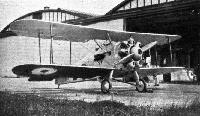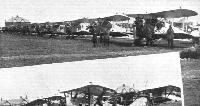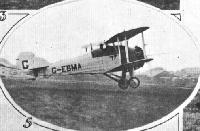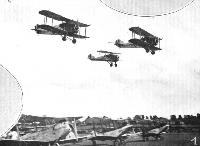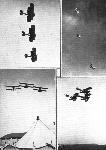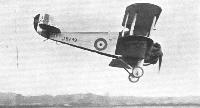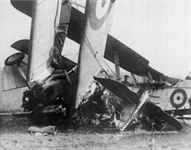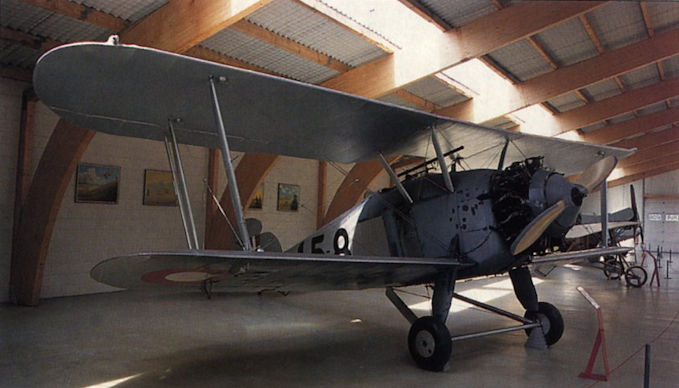
Hawker Woodcock
Самолет Woodcock спроектирован согласно спецификации 25/22 Министерства авиации к одноместному ночному истребителю. Планер прототипа Woodcock, позже получившего обозначение Woodcock Mk I, изготавливался из дерева и полотна. Он представлял собой типичный биплан с традиционным расчалочным хвостовым оперением, неубираемым шасси, выполненным по схеме с хвостовой опорой-костылем, и с силовой установкой со звездообразным мотором Armstrong Siddeley Jaguar II мощностью 358 л. с. На испытаниях в 1923 году Woodcock Mk I продемонстрировал крайне неудовлетворительные летные характеристики, поэтому был разработан новый прототип - Woodcock Mk II со звездообразным мотором Bristol Jupiter IV. Данный вариант показал на испытаниях достойные результаты, и после доработки хвостового оперения его одобрили к запуску в серию. Первые самолеты, пока без оборудования для ночных полетов, направили в войска для проведения эксплуатационных испытаний. А первый действительно ночной Woodcock Mk II передали в 3-ю истребительную эскадрилью в мае 1925 года.
Всего для британских ВВС был построен 61 самолет Woodcock Mk II, их эксплуатация продолжалась до 1928 года, хотя отдельные машины летали до 1936 года. Фирма построила также три модернизированных биплана Woodcock с мотором Jaguar IV для авиации Армии Дании. Эти самолеты именовались Danecock, в то время как 12 машин, построенных в Дании по лицензии, обозначались L.B.II Dankok; истребители находились в эксплуатации до 1937 года.
ТАКТИКО-ТЕХНИЧЕСКИЕ ХАРАКТЕРИСТИКИ
Hawker Woodcock Mk II
Тип: одноместный ночной истребитель
Силовая установка: один звездообразный ПД Bristol Jupiter IV мощностью 380 л. с.
Летные характеристики: максимальная скорость на уровне моря 227 км/ч; крейсерская скорость на оптимальной высоте 166 км/ч; время набора высоты 3050 м - 8 мин 25 с; практический потолок 6860 м; продолжительность полета 2 ч 45 мин
Масса: пустого 914 кг; максимальная взлетная 1351 кг
Размеры: размах крыла 9,91 м; длина 7,98 м; высота 3,02 м; площадь крыльев 32,14 м2
Вооружение: два неподвижных стреляющих вперед 7,7-мм пулемета Vickers по бортам в верхней носовой части фюзеляжа
Описание:
- Hawker Woodcock
- Flight, September 1924
THE SOPWITH-HAWKER WOODCOCK - Flight, January 1926
AN ANGLO-DANISH ALLIANCE - Flight, July 1928
THE HAWKER "WOODCOCK”
Фотографии
-
Мировая Авиация 154
Регистрационный номер: J7960 [2] На рисунке изображен Woodcock Mk II четвертой производственной серии из 17-й эскадрильи британских ВВС. Установка пулеметов для истребителей не совсем обычна - они открыто устанавливались снаружи бортов фюзеляжа.
-
Aeroplane Monthly 2000-07 / O.Hansen - 25 years of "Denmark's Shuttleworth" /Rare birds/
The Dankok fighter, a Danish-modified and -built version of the Hawker Woodcock, served until 1937. This unique survivor belongs to the Danish Arsenal Museum, but resides with the DV at Stauning as one of its static exhibits.
-
Aeroplane Monthly 1991-04 / O.Thetford, A.Lumsden - On silver wings (7)
Регистрационный номер: J6987 [3] Hawker Woodcock prototype J6987 with its original fin and second, enlarged, rudder. It was re-engined with a Jupiter IV, and later rebuilt to production standard and issued to 3 Sqn.
-
Aeroplane Monthly 1991-04 / O.Thetford, A.Lumsden - On silver wings (7)
Регистрационный номер: J6987 [3] The Woodcock was the first fighter to he produced by Hawker, but its qualities proved disappointing.
-
Aeroplane Monthly 1991-04 / O.Thetford, A.Lumsden - On silver wings (7)
Регистрационный номер: J6987 [3] The first prototype Hawker Woodcock J6987, fitted with its third fin and rudder. Note too the addition of tailplane struts - the elevator controls were now within the fuselage.
-
Flight 1924-06 / Flight
THE HAWKER "WOODCOCK": Another recent single-seater fighter biplane, fitted with a Bristol "Jupiter."
-
Flight 1924-07 / Flight
AT THE R.A.F. PAGEANT: Single-seater fighter - the Hawker "Woodcock" biplane (Bristol "Jupiter").
-
Aeroplane Monthly 1991-04 / O.Thetford, A.Lumsden - On silver wings (7)
Регистрационный номер: J6988 [4] The cowled Bristol Jupiter Mk IV radial engine of the second Woodcock prototype, J6988.
-
Flight 1924-09 / Flight
The Sopwith-Hawker "Woodcock," with Bristol "Jupiter" Engine: Three-quarter front view.
-
Aeroplane Monthly 1991-04 / O.Thetford, A.Lumsden - On silver wings (7)
Регистрационный номер: J6988 [4] The second prototype Hawker Woodcock, J6988, with the number 2 painted on the fuselage for the 1924 RAF Hendon display. Note the machine-gun located below the cockpit - another was installed on the port side.
-
Flight 1924-09 / Flight
Регистрационный номер: J6988 [4] THE SOPWITH-HAWKER "WOODCOCK": Three-quarter rear view.
-
Aeroplane Monthly 1988-05 / Personal album. Military
Регистрационный номер: J6988 [4] Hawker Woodcock Mk II prototype J6988 attended the 1924 Hendon Display before going to the A&AEE at Martlesham Heath that July.
-
Aeroplane Monthly 1991-04 / O.Thetford, A.Lumsden - On silver wings (7)
Регистрационный номер: J7974 Hawker Woodcock Mk II J7974 spent most of its life alternating between Hawker, the RAE, the A&AEE and 3 Sqn - its career ended in 1928 after spar failure. In this Brooklands photograph the Woodcock is fitted with slats.
-
Aeroplane Monthly 1991-05 / O.Thetford - On silver wings (8)
Регистрационный номер: J7971 Woodcock II J7971 of 17 Sqn.
-
Air International 1982-03 / Fighter A to Z
Регистрационный номер: J7517 The Woodcock II differed appreciably from the original Woodcock and served with RAF squadrons until 1928.
-
Flight 1925-07 / Flight
The Hawker "Woodcock" with 400 h.p. Bristol "Jupiter" engine, entered by Mr. T. O. M. Sopwith, will be piloted by Flight-Lieut. P. W. S. Bulman.
-
Aeroplane Monthly 1977-11 / Personal album
Регистрационный номер: J7960 [2] Hawker Woodcock single-seat fighter J7960, bearing the distinctive double zig-zag markings of No 17 Squadron, based at Hawkinge, along its fuselage sides. No 17 was the second of the two Woodcock squadrons, and received its first examples in March 1926.
-
Мировая Авиация 95
Март 1923г.: Hawker Woodcock, имевший вначале конструктивные недостатки и маломощный двигатель, совершил первый полет. После модернизации самолет широко использовался британскими ВВС.
-
Air Enthusiast 1971-09 / R.Braybrook - Biplane Era: The Flight from Reality /Fighters in the RAF/ (1)
The RAF’s first Hawker fighter was the Woodcock; two squadrons were equipped, Nos 3 and 17 (illustrated)
-
Aeroplane Monthly 1976-06 / Personal album
Регистрационный номер: J7515 [5], G-EBMA [5] A brace of Hawker Woodcock IIs, fitted with the 420 h.p. Bristol Jupiter IV. The foremost aircraft, J7515, was the fourth production aircraft. On July 1925 it was flown by Flt Lt P. W. S. Bulman in the King's Cup Race as G-EBMA, the only civil Woodcock, but crashed at Luton.
-
Aeroplane Monthly 1991-05 / O.Thetford - On silver wings (8)
Регистрационный номер: J7515 [5], G-EBMA [5] A line-up of 17 Sqn Woodcocks. The zig-zag squadron markings were black; engine cowlings were dark grey.
-
Flight 1928-07 / Flight
Регистрационный номер: J7515 [5], G-EBMA [5] R.A.F. DISPLAY AT BLACKPOOL: The huge crowd that visited the Blackpool Air Pageant on July 7 were lucky witnesses of a splendid imitation of the R.A.F. Display at Hendon. This view shows the familiar Air Force machines which took part: Hawker "Woodcocks"
-
Flight 1927-06 / Flight
THE SIR PHILIP SASSOON CUP RACE AT NORTHOLT: Two Hawker "Woodcocks" are here shown starting for the race.
-
Aeroplane Monthly 1991-05 / O.Thetford - On silver wings (8)
Регистрационный номер: G-EBMA [5], J7515 [5] Maj P. W. S. “George” Bulman taking off in pouring rain from Croydon on July 3, 1925 on the first leg of the King's Cup race. Bulman was forced to land at Luton because of the bad weather and the aircraft was damaged on landing. This demonstration aircraft was previously J7515.
-
Flight 1925-07 / Flight
Регистрационный номер: G-EBMA [5], J7515 [5] THE KING'S CUP: Some of the first day's starters. 5, Bulman on the Hawker Woodcock, dodging the rain.
-
Flight 1926-04 / Flight
MANOEUVRABILITY: The Hawker "Woodcock" with Bristol "Jupiter" engine doing a steeply-banked turn close to the ground near the Hawker sheds at Brooklands. The pilot was Mr. Bulman, chief test pilot to the H. G. Hawker Engineering Company.
-
Flight 1926-07 / Flight
The Hawker "Woodcock" (Bristol "Jupiter") Designed and built by the H. G. Hawker Engineering Co., which may be said to be carrying on the traditions of the late Sopwith Aviation Co., the "Woodcock" single-seater fighter may justly be regarded as the scion of a long family, commencing with the little Sopwith "Tabloid." The "Woodcock" is of normal straightforward design, but, as in so many other cases, appearances are deceptive, and the machine possesses features which a casual examination might fail to reveal. The Hawker "Woodcock" forms the standard equipment of No. 3 (Fighter) squadron, Upavon, and No. 17 (Fighter) squadron, Hawkinge.
-
Aeroplane Monthly 1991-04 / O.Thetford, A.Lumsden - On silver wings (7)
Регистрационный номер: J7962 [4] A Flight photograph of Hawker Woodcock Mk II J7962 being demonstrated for the Press at Brooklands on March 26, 1926. This aircraft later served with 3 Sqn and was based at RAF Kenley.
-
Flight 1931-06 / Flight
Регистрационный номер: J7962 [4] HAWKER "WOODCOCK": Single-seater Fighter, with Bristol "Jupiter" Engine
-
Flight 1926-04 / Flight
Регистрационный номер: J7962 [4] UPS AND DOWNS: Two views of the Hawker "Woodcock," piloted by Mr. Bulman, flying at Brooklands. When the photograph on the left was taken the machine was doing a banked left-hand turn close to the ground, our photographer enjoying a point of vantage above the machine.
-
Aeroplane Monthly 1991-04 / O.Thetford, A.Lumsden - On silver wings (7)
Регистрационный номер: J7962 [4] Another classic Flight photograph taken of the prototype Woodcock Mk II at Brooklands on March 26, 1926.
-
Flight 1928-05 / Flight
AT THE BRISTOL MEETING: The R.A.F. contribution was in the form of demonstrations, bombing and machine-gunning by three Hawker "Woodcocks" with Bristol "Jupiter" engines, here seen in formation "line astern."
-
Aeroplane Monthly 1990-07 / J.Yoxall - S.A. "Bill" Thorn /They who dared first/ (3)
Регистрационный номер: J8297 [3], J8300 [3] Another view of Woodcocks from 17 Sqn flying at the Bristol Air Pageant at Filton on June 22, 1927. Nearest the camera is J8297; Fg Off Bill Thorn is leading in J8300. Five days later J8300 caught fire on the ground at its RAF Upavon base.
-
Aeroplane Monthly 1991-05 / O.Thetford - On silver wings (8)
Регистрационный номер: J8297 [3], J8300 [3] A trio of 17 Sqn Woodcocks performing at the Bristol Air Pageant at Filton on June 22, 1927, led by Fg Off Thorn, later to become A. V. Roe’s chief test pilot. The aircraft had flown in from RAF Upavon.
-
Flight 1927-06 / Flight
Регистрационный номер: J8297 [3], J8300 [3] THE BRISTOL FLYING MEETING: 4, Three Hawker "Woodcocks" from No. 17 Squadron give a fine display
-
Flight 1926-09 / Flight
FORMATION FLYING EXTRAORDINARY: Daily visitors to Lympne during the light 'plane competition were "Grebes," "Woodcocks" and "Gamecocks," whose evolutions were generally admired. Our photographs show these machines in various formations.
Другие самолёты на фотографии: Gloster Grebe - Великобритания - 1923
-
Aeroplane Monthly 1991-05 / O.Thetford - On silver wings (8)
Регистрационный номер: J8303 [2] A trio of Hawker Woodcocks of No 3 Squadron taking off from RAF Upavon. The squadron flew Woodcock IIs from July 1925 until September 1928, when they were superseded by Gloster Gamecocks.
-
Aeroplane Monthly 1991-05 / O.Thetford - On silver wings (8)
Регистрационный номер: J8299 [2] Woodcock J8299 before it was delivered to 17 Sqn in April 1928.
-
Flight 1928-07 / Flight
Регистрационный номер: J8299 [2]
-
Flight 1926-01 / Flight
The Hawker "Danecock": Three-quarter front view. The engine is an Armstrong-Siddeley "Jaguar."
-
Мировая Авиация 154
Один из 12 бипланов L.B.II Dankok, построенных заводом Королевских ВМС Дании в 1927-1928 годах. Под нижним крылом смонтированы держатели для легких бомб.
A derivative of the Woodcock, the Danecock was licence-built by the Danish naval dockyard factory and remained in service with the Danish Navy until the mid-'thirties. -
Flight 1926-01 / Flight
THE HAWKER "DANECOCK": This front view gives a good idea of the large span single-bay bracing, and the generally "clean" lines of the machine.
-
Flight 1926-01 / Flight
The Hawker "Danecock": Side view. Note the Danish flag on the rudder.
-
Flight 1926-01 / Flight
The Hawker "Danecock": Three-quarter rear view.
-
Flight 1926-01 / Flight
CONTROLLABILITY: These two photographs of the Hawker "Danecock," photographed from another aeroplane, show two stages of a "slow roll" carried out by Flight-Lieut. Bulman, the firm's chief test pilot. In the larger photograph the machine is seen going into a left-hand roll, and the port ailerons can be seen to be in the maximum "up" position. In the inset the machine is on its back and is commencing to dive into a normal position.
-
Flight 1931-06 / Flight
"THAT WAS A GOOD AEROPLANE THAT IS": Reversing the now famous "Shell" slogan seems apt in connection with this Hawker "Danecock" with Armstrong-Siddeley "Jaguar" engine which, although delivered by the Hawker Company to the Danish Naval Air Service in 1924, has recently won the Nordic Cup Competition piloted by Lieutenant Erik Rastnussen, Royal Danish Navy. The course was one of 800 miles, and pilots from Norway, Sweden, Finland and Denmark took part. The "Danecock" is still the standard fighter in Denmark, and the same officer and machine still hold the Scandinavian altitude record established just over two years ago.
-
Flight 1926-01 / Flight
AN ANGLO-DANISH ALLIANCE: This series of photographs show the Hawker "Danecock" with Armstrong-Siddeley "Jaguar" engine, of which three were recently delivered to the Danish Government. A further number will be built at the Naval dockyards at Copenhagen. These photographs were secured during a test flight at Brooklands recently, and show the machine in a number of various attitudes. The pilot was Flight-Lieut. Bulman.
-
Flight 1926-01 / Flight
An Anglo-Dane Alliance: In this group are seen representatives of the Hawker Engineering Company, Armstrong-Siddeley Motors, and the Danish Government. From left to right: Capt. Proctor (Armstrong-Siddeley), Mr. L. A. Pollard (Hawker), Mr. C. V. Thymann (Royal Danish Navy), Mr. H. K. Jones (Hawker), Lieut. P. W. S. Bulman (Hawker), Lieut.-Commander Victor (Royal Danish Navy), and Mr. F. I. Bennett (Hawker)
-
Aeroplane Monthly 1977-07 / Hawker Danecock /Preservation Profile/ (51)
Dismantled at the Royal Naval Air Station, Copenhagen, 1938-39
-
Aeroplane Monthly 1977-07 / Hawker Danecock /Preservation Profile/ (51)
158 in service with 2 Luftflotille, Ringsted, 1930
-
Aeroplane Monthly 1977-07 / Hawker Danecock /Preservation Profile/ (51)
Restored, with Spitfire wheels, at Vaerloese, circa 1955
-
Air Enthusiast 1971-09 / The Great Danes /Veteran & Vintage/
A prized exhibit in the Copenhagen museum of the Royal Danish Arsenal is the Hawker Dancock, only surviving example of this 1927 biplane with an Armstrong-Siddeley Jaguar IV radial engine. No 158 is one of the 12 Dancocks built at the Danish Naval Dockyard.
-
Aeroplane Monthly 1977-07 / Hawker Danecock /Preservation Profile/ (51)
On display in the Arsenal Museum, Copenhagen
-
Aeroplane Monthly 1974-08 / Personal album
Регистрационный номер: J7973 How to write-off a Woodcock. The radial-engined remains belong to Hawker Woodcock II J7973, and the second party is a de Havilland D.H.9A. Fg Off Shipwright was injured in this accident. Only Nos 3 and 17 Squadrons had Woodcocks, and the type was in service as a night interceptor fighter from 1925 until 1928.
Другие самолёты на фотографии: De Havilland D.H.9A - Великобритания - 1918
-
Aeroplane Monthly 1993-09
Harry Hawker
-
Aeroplane Monthly 1991-04 / O.Thetford, A.Lumsden - On silver wings (7)
Регистрационный номер: J8292, J8303 [2] KEITH WOODCOCK'S painting portrays Hawker Woodcocks J8303 and J8292 of 3 Sqn.
-
Aeroplane Monthly 1991-05 / O.Thetford - On silver wings (8)
Hawker Woodcock squadron colours
Key to sketches: A & B Woodcock J8303 of 3 Sqn, Upavon, 1926. C, D & E J8295 of 17 Sqn, Upavon, 1927. This was the aircraft used by Charles Lindbergh in June 1927 after his transatlantic flight. -
Air International 1982-03 / Fighter A to Z
The Woodcock II differed appreciably from the original Woodcock and served with RAF squadrons until 1928.
- Фотографии









